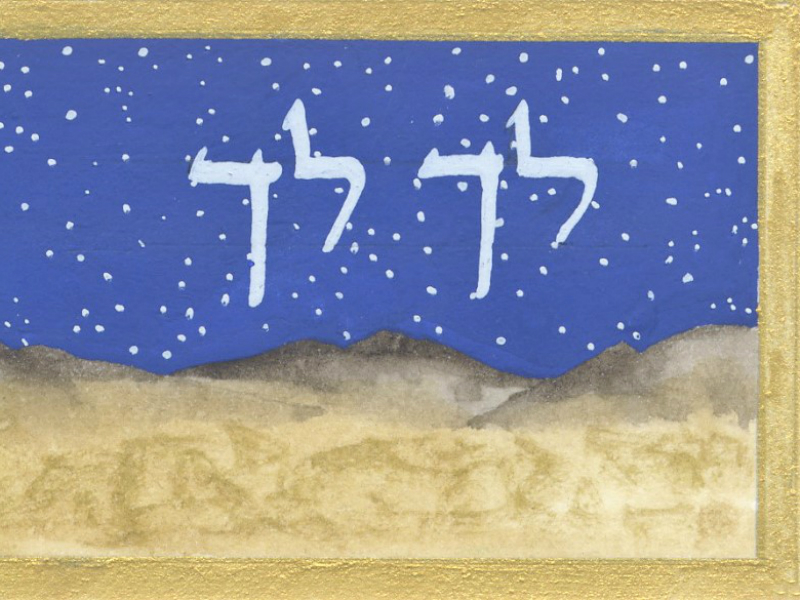Toronto’s Beth David B’nai Israel Beth Am synagogue may possess one of the most unique items in modern Judaica: a haftarah scroll with accompanying illustrations that were created by artist Laya Crust.
The haftarah is a selection of weekly readings from Prophets. Each haftarah portion corresponds to a weekly Torah parashah and a few additional haftarah portions are read on holidays.
“Every portion in the Beth David haftarah has a picture,” Crust said in an interview with The CJN. “I wanted it to be something we could relate to.”
Enlarged prints of these illustrations are currently on display at Beth Tzedec Congregation in Toronto. The exhibition, which was mounted by the synagogue’s museum, will run until Oct. 31.
When Beth David purchased a parchment haftarah scroll, the congregation wanted “something colourful to go along with each haftarah portion,” but they were not sure what kind of art they were looking for, Crust recounted.
“I came up with the idea of doing an illustration for each portion. I made up a proposal of ideas of what could be done as an image. They gave me carte blanche to create whatever I wanted.”
READ: BRAINS SET TO TAKE OVER TORONTO STREETS
Crust grew up in Winnipeg, but has spent most of her adult life in Toronto. The mother of six and grandmother of four has been an artist for some 40 years.
She has done contemporary work in a variety of mediums, including watercolour, fabric, glass, clay and ink. Her works are in private collections around the world.
She gets a lot of commissioned Judaica work from individuals and organizations. “Most of the work I do is watercolour on paper, often combined with lettering,” she said.
“When I started integrating lettering into my work, that’s when I started doing Judaica. I was always drawn to that. I did a ketubbah for a friend and that led to more ketubbot commissions.… I have created over 600 ketubbot over the years.”
There are 82 haftarah portions – 54 for Shabbat and 28 holiday and special haftarahs, but Crust created 88 illustrations, as she gave some portions two images.
The whole process of creating the images started with her reading of a particular haftarah and the accompanying parashah. “From the reading, I would see what meaning came to me; what phrases or incident stood out to me,” she said.
For instance, in Lech Lecha, the parashah in which God tells Abraham that his descendants would be as numerous as the stars in the sky, Crust did an illustration of the night sky filled with stars. However, she then created a second illustration to reflect the corresponding haftarah, in which Isaiah speaks about “the ends of the earth.”
She said she was looking for something to do with geography, when she learned about Abraham Cresques, a Jewish cartographer from Spain who lived in the 14th century. “He introduced navigational map-making and other innovations that improved ship navigation,” she said.
The Catalan Atlas, which Cresques created in 1375, was Crust’s inspiration for her drawing that accompanies the haftarah to Lech Lecha.
She believes the biblical stories are applicable to modern life, saying that, “They really represent how people think and behave.”
For instance, her illustration of the companion haftarah to Parashat Shemini shows the deterioration of the relationship between King David and Michal. When the king was dancing in front of the tabernacle, his robes opened accidentally and he ended up exposing himself.
“His wife thought his behaviour was not regal and she chided him for it,” Crust said.
The image she created for this haftarah is based on an illumination from an old Judaic manuscript: “The image shows King David dancing in the finery of his flowing robes … while Michal is on a balcony looking down at him with derision,” said Crust.

Crust’s illustrations draw from all kinds of Jewish sources, including medieval illuminated manuscripts, Chagall paintings, Art Spiegelman’s Maus and other Holocaust imagery.
People do not associate the Jews with the visual arts, Crust said. “We have a rich history of art – mosaics, frescos, pottery, decoration through painting and illumination and photography.…
“Most people are unaware of our art history. My dream is to bring our history, our art and our way of living all together so people can see what Jewish culture has to offer.”
